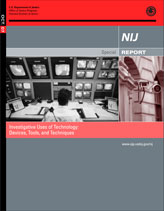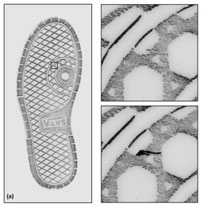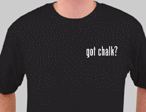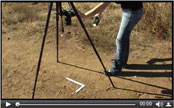|
View in browser: http://www.crime-scene-investigator.net/newsletter/0318.html
|
||
|
MARCH 2018 | ||
This month's newsletter is brought to you by the 2018 CSI Summer Academy
| ||
|
This Month's Featured Resource on the Crime Scene Investigator Network Website
|
||

This special report is intended to be a resource to any law enforcement personnel (investigators, first responders, detectives, prosecutors, etc.) who may have limited or no experience with technology-related crimes or with the tools and techniques available to investigate those crimes. It is not all inclusive. Rather, it deals with the most common techniques, devices, and tools encountered. Technology is advancing at such a rapid rate that the information in this special report must be examined in the context of current technology and practices adjusted as appropriate. It is recognized that all investigations are unique and the judgment of investigators should be given deference in the implementation of this special report. |
||
|
Featured Video Presentation
|
||
|
Learn the basic technique for photographing footwear impressions. |
||
|
New CSI and Forensic Job Announcements
|
||
|
The most comprehensive listing of Crime Scene Investigation and Forensic To be notified of job openings as they are posted, follow us on Twitter: Job Posting Alerts |
||
|
Police Identification Technician
Redondo Beach Police Department, Redondo Beach, California, USA Final Filing Date: April 1, 2018 Participates in and may direct work involved in the location, isolation, identification, analysis, preservation, collection, and processing of forensic materials, DNA, trace, fingerprints and other physical evidence in a laboratory and/or field setting by conventional, chemical or alternate light source technology. Detects, compares, classifies, assesses and processes latent fingerprints and other evidence to determine its usefulness as evidence. <View complete job listing> |
||
|
Crime Scene Investigator I
San Antonio Police Department, San Antonio, Texas, USA Final Filing Date: Open until filled Photographs and videotapes crime scene. Searches crime scene thoroughly for physical evidence. Collects, marks, and preserves physical evidence and latent fingerprints. Prepares diagram of crime scene and other reports. Presents forensic evidence in official proceedings. <View complete job listing> |
||
|
Forensic Unit Supervisor
Spokane County Sheriff's Department, Spokane, Washington, USA Final Filing Date: April 3, 2018 The Forensic Unit Supervisor is responsible for supervisory functions of the Forensic Unit which includes the day-to-day operations of the Spokane County-City Forensic Unit. Supervise employees and interns in the day-to-day operations of the Forensic Unit. This includes the oversight of the Public Fingerprint Counter, the digital lab, latent processing labs, crime scene response teams, fingerprint examinations, and automated identification system. <View complete job listing> |
||
 |
||
|
Forensic Firearms Examiner
North Louisiana Criminalistics Laboratory, Shreveport, Louisiana, USA Final Filing Date: April 1, 2018 The scientist in this position is assigned individual cases to completely work from evidence examination to report writing. The laboratory performs firearms and tool marks examinations, serial number restoration, distance determination, and fingerprint processing. <View complete job listing> |
||
|
State Patrol Forensic Scientist
Nebraska State Patrol, Lincoln, Nebraska, USA Final Filing Date: March 30, 2018 Two positions will perform screening and subsequent DNA testing of evidence in all types of criminal cases (e.g. sexual assault, homicide, burglary, etc.) and two positions will be assigned to a three year project to perform screening and DNA testing on previously untested sexual assault kits. <View complete job listing> |
||
|
Forensic Analyst - Audio/Video
Houston Forensic Science Center, Houston, Texas, USA Final Filing Date: Open until filled Analysis of audio and video evidence, whether analog or digital in nature, used in criminal investigations. Specialized technical work in the clarification/enhancement, conversion, repair, and reconstruction of audio and video evidence. Retrieval of evidence from analog and digital CCTV systems, both in the lab and at crime scenes. <View complete job listing> |
||
|
Search for more job listings in Crime Scene Investigations and Forensics To be notified of job openings as they are posted, follow us on Twitter: Job Posting Alerts |
||
|
Other Resources on the Crime Scene Investigator Network Website
|
||
|
Not Subscribed to this Newsletter?
|
||
|
If you are not subscribed to this newsletter, you may subscribe with this link: SUBSCRIBE via email |
||
|
To Unsubscribe
|
||
|
To unsubscribe from future e-mail newsletters, please click here: UNSUBSCRIBE Copyright ©2018 Crime Scene Resources, Inc. Crime Scene Investigator Network |


 The National Academy of Sciences (NAS) 2009 report on Strengthening Forensic Science in the United States revealed several research recommendations related to forensic footwear examinations, including the need for greater clarity concerning the variability of outsole class and individual (randomly acquired) characteristics (RACs), the validity and reliability of current methods and practices, the relative frequency of features, and the appropriate use of statistical standards (NAS, 2009). In response to this request, this project performed foundational research to clarify the empirical frequency and shape distribution of randomly acquired characteristics on outsoles collected from a general population.
The National Academy of Sciences (NAS) 2009 report on Strengthening Forensic Science in the United States revealed several research recommendations related to forensic footwear examinations, including the need for greater clarity concerning the variability of outsole class and individual (randomly acquired) characteristics (RACs), the validity and reliability of current methods and practices, the relative frequency of features, and the appropriate use of statistical standards (NAS, 2009). In response to this request, this project performed foundational research to clarify the empirical frequency and shape distribution of randomly acquired characteristics on outsoles collected from a general population.




